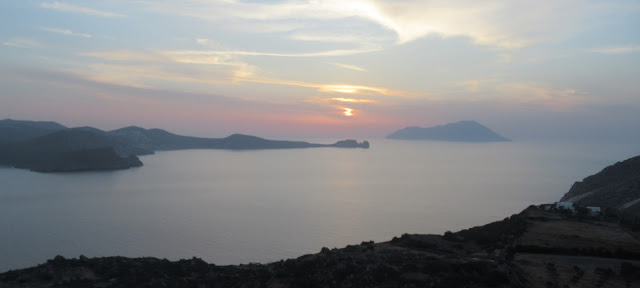Plaka is the capital of Milos and the largest village. It's a typical Cycladic settlement with whitewashed houses, narrow lanes, churches and a medieval castle on top of the hill.
A small church near where the bus dropped us off
it's quite a haul to get to the old part of the village
views of the village of Tripiti from here
and we continued climbing
This is the way to the castle but we heard whilst on the bus that there was a church fair on that day and we were keen to take part in that
so we continued towards the main square
 We got to the main square
We got to the main square
which is full of bars, cafes and restaurants
but more seating was being set up in preparation for the fair which was due to start at 9:00views of the top of the hill, its church and the castle, and also, lower down, Archondula, the taverna where we ended up eating
even though it was still early, lots of people were eating. This is also Archondula, the sister taverna to the one above
Fun ceramics in one of the shops we went into
Up the stairs and a door to the balcony
It was getting sunset time, so down this alleyway
to the Utopia cafe, the best place to watch the sunset in comfort with a drink in our hand.
But, things have changed since eight years ago, and everyone knows about Utopia now, so absolutely no places to sit, and a long queue of people waiting. I said to the waiter: 'I presume that as in the past, once the sun disappears everyone will get up and go?' He said: 'yes, some of them queue for two hours to get a seat, but once the sun is down you should be ok'.
So we went to the church,
where, from its balcony you can watch the sun setting
over the sea and the end of the bay which used to be the volcano's crater
I sat on the ledge, and enjoyed...
We then moved on
found this shop
where the guy took the most amazing photographs
and his colleague made beautiful jewellery
The square was getting quite busy by then
But we chose to go to Utopia, found a table right by the front
and enjoyed the view until it got too dark to see anything.
By then it was time to eat, and we tried Archondoula, but no tables available for a long time

So we tried the other Archondoula and by a miracle, found a table. Our waiter, when he came to serve us said: 'do you realise how lucky you were?' and I said, we did indeed. Lucky in more ways than one,
as right in front of us, the festival was in full swing.
The band played right in front of us
and we could see all the people dancing
 By then the whole of the village square was packed, people standing listening to the band and watching the dancing.
By then the whole of the village square was packed, people standing listening to the band and watching the dancing.
The children started first
and they were later joined by the adults.
It was such a fun evening.
Three days later we went back to Plaka and chose Diporto for our evening meal.



















































